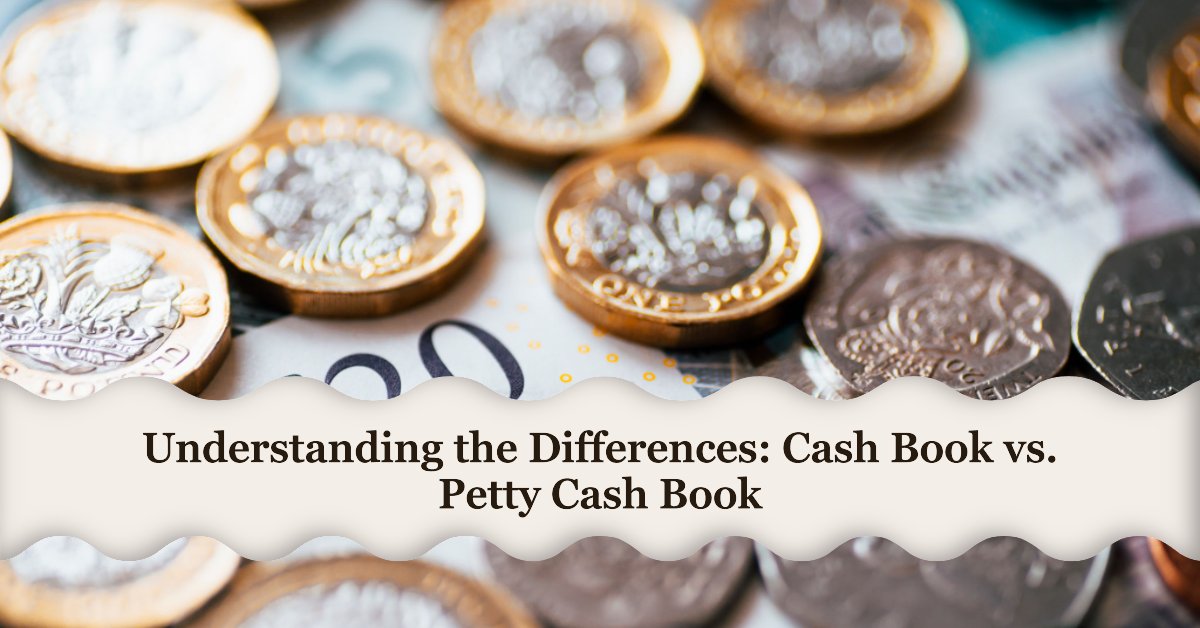
In any business, proper management of cash transactions is essential for maintaining financial control and accurately tracking cash flow. One of the fundamental tools for recording and monitoring cash activities is the cash book.
In this blog post, we will delve into the concept of a cash book, explore different formats, and highlight the key differences between a cash book and a petty cash book.
A cash book is a financial ledger that serves as a central repository for recording all cash transactions within a business.
It provides a detailed record of cash inflows and outflows, enabling accurate tracking of the organization’s cash position.
The cash book is typically maintained by the main cashier or the accounting department.
There are various formats of cash books, depending on the specific needs and preferences of the business. Here are three common formats:
Single Column Cash Book:
| Date | Particulars | L.F. | Amount |
|---|---|---|---|
| DD/MM/YYYY | Opening Balance | Dr./Cr. | |
| Cash Receipts | |||
| - Source 1 | Dr. | ||
| - Source 2 | Dr. | ||
| Cash Payments | |||
| - Payment 1 | Cr. | ||
| - Payment 2 | Cr. | ||
| DD/MM/YYYY | Closing Balance | Dr./Cr. |
In the single column cash book, there is only one column to record cash transactions.
Example:
| Date | Particulars | L.F. | Amount |
|---|---|---|---|
| 01/01/2023 | Opening Balance | 10,000 Dr. | |
| 05/01/2023 | Cash Receipt | 5,000 Dr. | |
| 08/01/2023 | Cash Payment | 2,500 Cr. | |
| 10/01/2023 | Cash Receipt | 3,000 Dr. | |
| 15/01/2023 | Cash Payment | 1,200 Cr. | |
| 31/01/2023 | Closing Balance | 14,300 Dr. |
Double Column Cash Book:
| Date | Particulars | L.F. | Cash | Bank |
|---|---|---|---|---|
| DD/MM/YYYY | Opening Balance | Dr./Cr. | ||
| Cash Receipts | ||||
| - Source 1 | Dr. | |||
| - Source 2 | Dr. | |||
| Cash Payments | ||||
| - Payment 1 | Cr. | |||
| - Payment 2 | Cr. | |||
| DD/MM/YYYY | Closing Balance | Dr./Cr. |
Example :
| Date | Particulars | L.F. | Cash | Bank |
|---|---|---|---|---|
| 01/01/2023 | Opening Balance | 5,000 Dr. | ||
| 05/01/2023 | Cash Receipt | 3,000 Dr. | ||
| 08/01/2023 | Bank Deposit | 2,500 Dr. | ||
| 10/01/2023 | Cash Receipt | 2,000 Dr. | ||
| 15/01/2023 | Bank Withdrawal | 1,200 Cr. | ||
| 31/01/2023 | Closing Balance | 9,800 Dr. |
In the double column cash book, there are separate columns for recording cash transactions and bank transactions.
The cash column is used to record cash receipts and cash payments, while the bank column is used to record bank-related transactions.
Format:
| Date | Particulars | L.F. | Cash | Bank | Discount |
|---|---|---|---|---|---|
| DD/MM/YYYY | Opening Balance | Dr./Cr. | |||
| Cash Receipts | |||||
| - Source 1 | Dr. | ||||
| - Source 2 | Dr. | ||||
| Cash Payments | |||||
| - Payment 1 | Cr. | ||||
| - Payment 2 | Cr. | ||||
| DD/MM/YYYY | Closing Balance | Dr./Cr. |
Example:
| Date | Particulars | L.F. | Cash | Bank | Discount |
|---|---|---|---|---|---|
| 01/01/2023 | Opening Balance | 5,000 Dr. | |||
| 05/01/2023 | Cash Receipt | 3,000 Dr. | |||
| 08/01/2023 | Bank Deposit | 2,500 Dr. | |||
| 10/01/2023 | Cash Receipt | 2,000 Dr. | |||
| 15/01/2023 | Bank Withdrawal | 1,200 Cr. | |||
| 31/01/2023 | Closing Balance | 9,800 Dr. |
In cash book format, each entry includes the date, a brief description of the transaction (particulars), the amount of cash received (receipts), the amount of cash paid (payments), and the resulting balance after each transaction.
The petty cash book is a specialized ledger used to record small, routine expenses that do not warrant individual entries in the main cash book. Here is a common format for a petty cash book:
Format:
| Date | Particulars | Voucher No. | Amount |
|---|---|---|---|
| DD/MM/YYYY | Opening Balance | Dr./Cr. | |
| Cash Receipts | |||
| - Source 1 | Dr. | ||
| - Source 2 | Dr. | ||
| Cash Payments | |||
| - Payment 1 | Cr. | ||
| - Payment 2 | Cr. | ||
| DD/MM/YYYY | Closing Balance | Dr./Cr. |
Example:
| Date | Particulars | Voucher No. | Amount |
|---|---|---|---|
| 01/01/2023 | Opening Balance | 500 Dr. | |
| 05/01/2023 | Office Supplies | V-001 | 200 Dr. |
| 08/01/2023 | Refreshments | V-002 | 100 Dr. |
| 10/01/2023 | Taxi Fare | V-003 | 50 Dr. |
| 15/01/2023 | Petty Cash Replenish | 300 Cr. | |
| 31/01/2023 | Closing Balance | 250 Dr. |
The petty cash book format is relatively simpler, with columns for the date, a brief description of the expense (particulars), and the amount spent.
While both cash book and petty cash book deal with cash transactions, they serve different purposes and have distinct characteristics:
The cash book is an indispensable tool for businesses to effectively manage and monitor cash transactions. By maintaining accurate records of cash inflows and outflows, businesses can ensure financial control, make informed decisions, and maintain transparency in their financial operations. It is crucial to understand the different formats of the cash book and its distinction from the petty cash book to implement effective cash management practices within an organization.